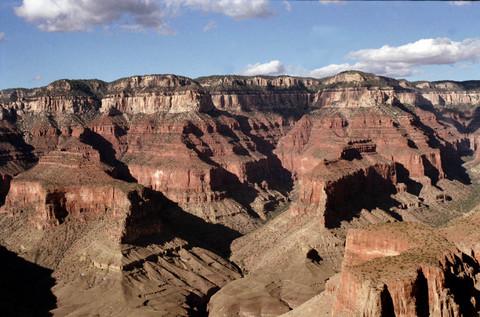Air tours are a key segment of the tourism industry in more than a few national parks. It seems that in more and more parks you can board a plane or helicopter for a quick aerial reconnaissance of the parkscape down below.
But for folks hiking or backpacking in the parks' backcountry, these overflights can be a disturbing nuisance as they muffle the sounds of birds singing, of rivers flowing, of wildlife clattering about.
What's the solution? Back in 1987 Congress passed the National Parks Overflight Act (attached below) that many thought would speed an answer. Well, nothing seems speedy when the federal government is involved. In the case of park overflights, the issue is even more complicated because the Federal Aviation Administration believes it should have the final say over what goes on in the air over national parks, not the National Park Service.
Now, against this backdrop, there have been ongoing efforts at Grand Canyon National Park (and other parks) to achieve a balance, one that won't put air tours out of business and yet will provide a measure of "natural quiet" in the park down below. Earlier this spring the Park Service, supposedly with intentions of moving a step closure toward a good solution, proposed to redefine how it measures "natural quiet" in the park.
With the public comment period on that proposal set to expire on May 9, a coalition of groups has asked that the comment period be extended by 30 days.
Exactly how natural quiet is defined plays a key role in managing air tours over the canyon. If you read the newly proposed definition (attached below), it does seem a bit unclear. Here it is:
“a) Substantial restoration of natural quiet at Grand Canyon National Park will be achieved when the reduction of noise from aircraft operations at or below 17,999 feet Mean Sea Level (MSL) results in 50% or more of the park achieving restoration of the natural quiet (i.e., no aircraft audible) for 75% to 100% of the day, each and every day; and b) The NPS defines the substantial restoration of natural quiet from all aircraft above 17,999 feet MSL, to mean that there will be an overall reduction in aviation noise generated above 17,999 feet MSL above the park over time through the implementation of measures in accordance with FAA commitments.”
The NPS also clarifies that 50% of Grand Canyon National Park is a minimum in the restoration goal. This includes not only the impacts of aircraft noise on the soundscape but the impact of noise on the visitor experience and natural, cultural and historic resources for the entire park.
What's unclear to me is how much impact this new definition might have on commercial aircraft. While it would seem to directly limit the noise from air tours flying below 18,000 feet, it seems to have little teeth in silencing the noise from commercial or military aircraft above that altitude.
Indeed, the existing definition seems positioned to do a better job in restoring natural quiet over the park: In a 1995 Report to Congress entitled “Report on Effects of Aircraft Overflights on the National Park System”, the NPS defined substantial restoration of natural quiet at Grand Canyon National Park to mean, “50 % or more of the park achieve ‘natural quiet’ (i.e., no aircraft audible) for 75-100 percent of the day.”
In seeking the 30-day extension, Arizona Raft Adventures, Grand Canyon Trust, National Parks Conservation Association, Nature Sounds Society, River Runners for Wilderness, the Sierra Club, and The Wilderness Society contend that the initial 30-day public comment period was not long enough for all those interested in the Grand Canyon to submit comments.
"Also, the issue of restoring natural quiet to Grand Canyon National Park, mandated by federal legislation in 1987 (the National Parks Overflight Act of 1987), has been the subject of great interest throughout the years by conservationists, recreationists, and other park visitors," the groups say. "Seeing the promise of the 1987 law fully enacted is worth the time to gather all relevant comments from those groups and individuals who have followed this issue for decades."




Comments
Comment periods are open to everyone and all parties interested in the National Parks need to take advantage of them. In reading your article on the GCNP overflight comment period I did not see a link or information to where to send our comments. Would you please provide that informaion in future columns and add it to this one? Thanks!
Yes, a permanent web page of issues and comment periods with how to / where to voice our opinions would be very advantages for us “National Parks Traveler" users.
Yes, "nothing seems speedy when the Federal government is concerned", but at the end of the day, that is probably one of the advantages of democracy - not one of detriments. Extended periods of consultation have been used by defenders of the Parks on many occasions to prevent ill-considered decisions that would adversely affect the Parks or the government at large. In this case, I do look forward to improved natural quiet at Grand Canyon. At the same time, I am somewhat comforted by the fact that the Federal Government is being rather slow and deliberate about making a decision that would ultimately cost some well-meaning individuals their jobs.
The Feds doesn't really give a damn or two about the improvement of parks. They have far more important things to do than attend to the needs of these people who care for it. It's a sad trend, if we think about it.